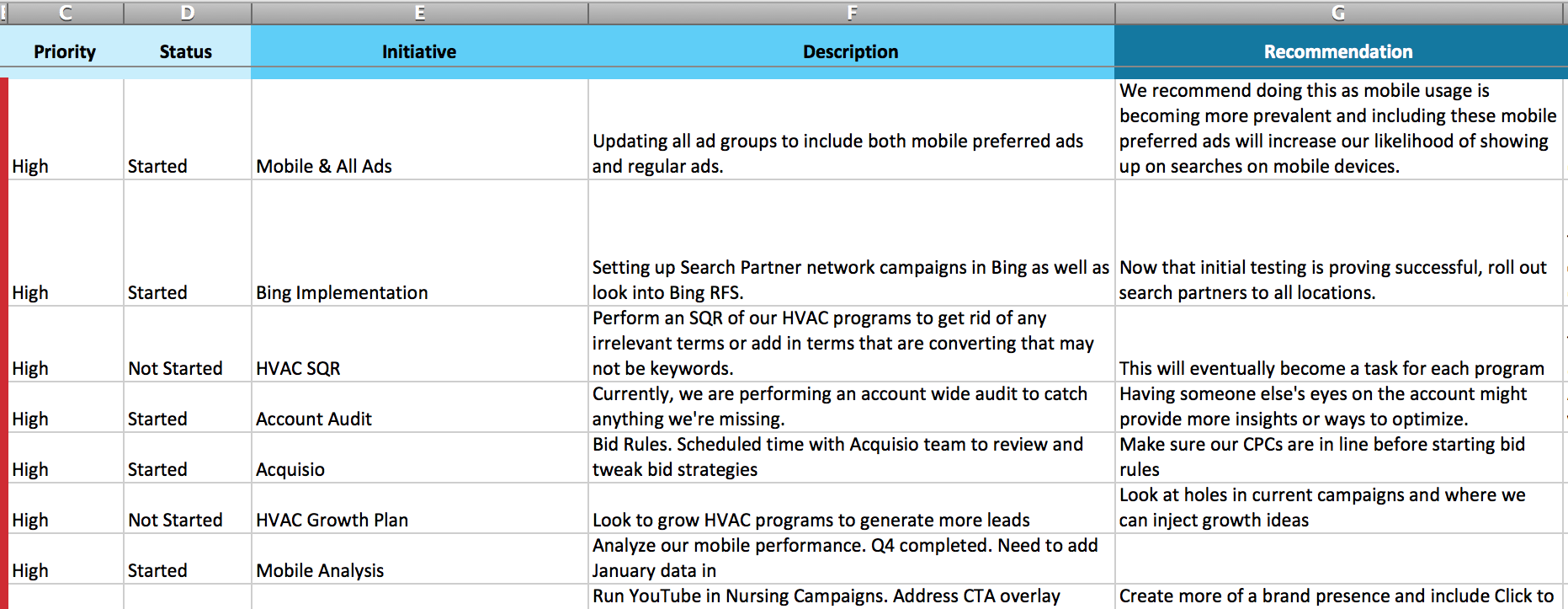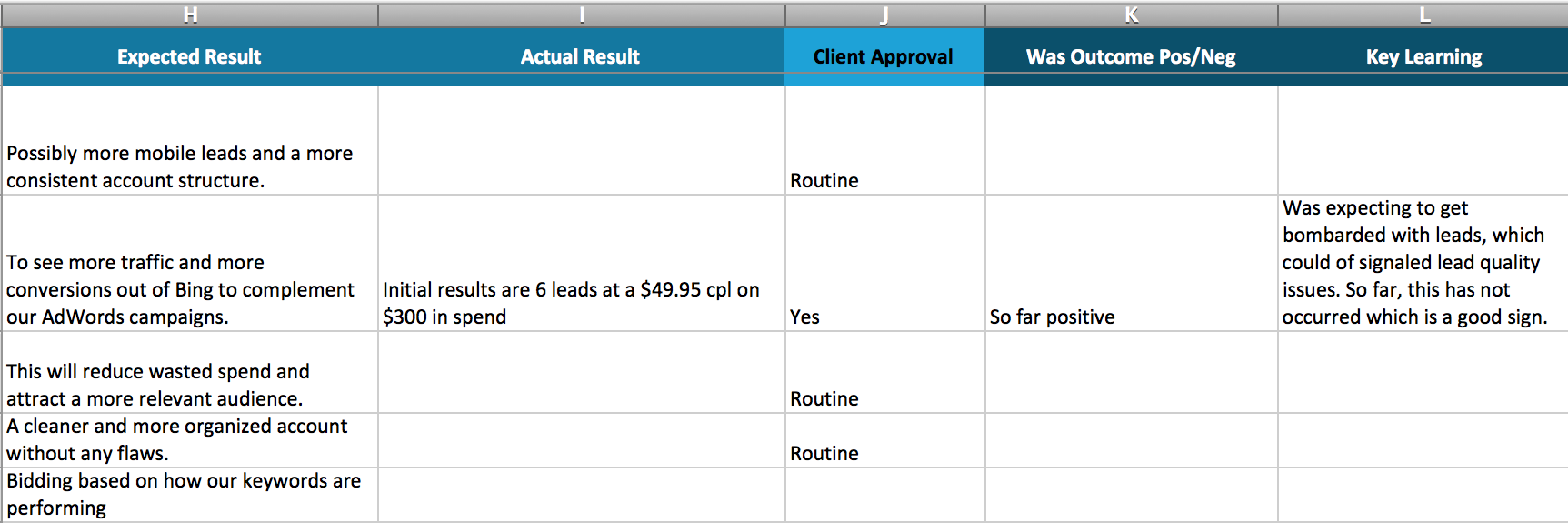My account team was recently assigned a new client. The relationship appeared to get off to a good start with clear goals established and performance on target towards meeting those goals. However, the client expressed concern about not having a strong strategy in place and a clear direction for moving the PPC program forward.
Today we’re going to discuss in detail how we adjusted our communication style and how that adjustment ultimately turned an anxious client into one that was full of trust and confidence in Hanapin’s ability to grow its paid search account.
Enhanced Status Document
I often emphasize to my team the importance of clear and precise client communications. However, what I’ve learned is that ‘clear and precise communication’ means different things to different people. We had to figure out what style of communication worked with this particular client, and fast.
The first adjustment was to convert our standard status document into an ‘enhanced status doc’. Our standard status document outlines what projects an account manager is working on, due date for completion, and whether or not the project has been completed.
The ‘enhanced status doc’ contains more detail than the standard doc because it encompasses in-depth project descriptions, supporting reasons for open projects, and key insights and learning’s. Below are examples of an enhanced status doc and a detailed description of what each initiative is trying to accomplish.
- Priority: All projects are ranked in bucket of importance. The buckets of importance are ‘high’, ‘medium’ and ‘low’. The purpose of this column is to provide an easy read out of the order in which specific projects are being work on at any given moment.
- Status: The purpose of this column is to clearly denote whether or not work on a specific project has commenced.
- Initiative: A simple description that provides a summary of the project.
- Description: Provides a thorough explanation of what the project or task is. The purpose of this field is to provide very specific details surrounding the project or task. Client’s not fluent in paid search find this description field particularly useful.
- Recommendation: Provides thorough reasoning and justification regarding why a project should or is being undertaken. The recommendation field provides the ‘why’ behind the work being completed.
- Expected Result: This area of the doc is where expectations are communicated. Often, clients and Account Managers have differing expectations regarding results. Providing expected results protects against unreasonable expectations and reduces the chance of disappointment when actual results begin to accrue.
- Actual Result: Performance data from projects are entered into this field for comparison against expectations.
- Client Approval: This area of the doc is proof of agreement that a project is ok to commence.
- Positive or Negative Outcome: Did the completed work achieve positive or negative results? The purpose of this column is to spark discussion regarding whether or not to continue with the initiative.
- Key Learning: What did we learn from working on a specific project or task? Document whether or not what was learned can be converted into actionable items.
I bet your thinking by now “This is a lot of work and why is it so important?”
The enhanced status doc was critical in turning our client relationship around because it forced us stop checking items off the list and document all of our strategies and tactics. Additionally, the enhanced status doc forced us to honestly confront if our work was task based or outcome driven.
Force The Client to Engage
The next adjustment our team made was to force the client to engage more heavily during phone calls. Our first few calls were pleasant as the client was ‘a nice guy’. However, he didn’t offer his opinion or ask questions, which led us to believe everything was ok. What we failed to understand was his lack of an opinion or asking questions because he didn’t understand PPC very well, which in turn meant he didn’t understand our strategy and direction.
How did we fix this problem? First off, the account team asked the client questions frequently during our phone calls such as ‘Do you have any questions, comments, or concerns? And ‘What should we continue, stop, or start doing’? Asking these questions forces clients to engage and prevents them from saving up their grievances for a later time. Addressing objections on the spot reduces the chance of them turning into major issues down the road which could result in clients leaving.
Finally, we specifically asked the client for buy in, agreement, and sign off on strategy and tactics. As account managers, its not our job to dictate direction and make business decisions on our client’s behalf. Our role is to provide analysis, insight, and provide a recommended approach. This strategy allows clients to make the ultimate choice regarding the direction of their PPC accounts. If clients have the power to choose, they can’t say you forced them in a direction that’s not agreeable to them.
Recap of What We Learned
Our account team learned valuable lessons through this client interaction. Keep these lessons in mind when proceeding with your client relationships.
- Learn quickly how your client contacts processes information and adapt your style accordingly to meet their needs.
- Always follow up verbal discussions with a written recap to avoid misunderstandings.
- Explain the ‘why’ behind what you’re working on.
- Force the client to engage, and deal with objections on the spot to avoid bigger issues down the road.
How Did Our Situation Turn Out?
Employing this more rigorous approach to our daily account management immediately turned what could of become an unhappy client into one that was full of confidence and excited about the prospects of PPC.
Employing the ‘enhanced status doc’ requires additional work to create and more time must to be devoted to preparing for client calls and other forms of communication. However, having a happy client reduces stress, which is invaluable, and saves time by not having to spend large portions of your day putting out client relationship fires.






